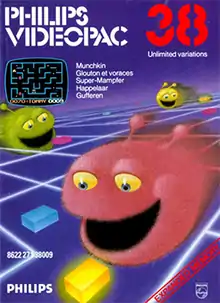K.C. Munchkin!
Munchkin is cartridge number 38 in the official Philips line of games for the Philips Videopac. In North America for the Magnavox Odyssey 2 it was called K.C. Munchkin!, an inside reference to then president of Philips Consumer Electronics Kenneth C. Menkin.
| Munchkin (Europe) K.C. Munchkin! (US) | |
|---|---|
 European cover | |
| Publisher(s) | Philips, Magnavox |
| Designer(s) | Ed Averett |
| Platform(s) | Philips Videopac (Europe) Magnavox Odyssey 2 (US) |
| Release | 1981 |
| Genre(s) | Maze |
Designed and programmed by Ed Averett, Munchkin is very heavily based on Namco's 1980 arcade game Pac-Man, but not a direct clone. It was, however, similar enough for Atari to sue Philips and force them to cease production of Munchkin. Atari was exclusively licensed to produce the first play-at-home version of Pac-Man, but Munchkin hit store shelves in 1981, a year before Atari's game was ready. Atari initially failed to convince a U.S. district court to halt the sale of Munchkin, but ultimately won its case on appeal. In 1982, the appellate court found that Philips had copied Pac-Man and made alterations that "only tend to emphasize the extent to which it deliberately copied the Plaintiff's work." The ruling was one of the first to establish how copyright law would apply to the look and feel of computer software.[1]
Gameplay differences
Munchkin plays much like Pac-Man, with the following key differences:
- There are only 12 pills (called munchies) in each maze, which begin in four groups of three but move through the maze independently and at speeds that increase as each one is eaten. The final munchie moves at the same speed as the Munchkin and must be intercepted rather than followed.
- The super-pills are called blinking munchies because they flash and change colour.
- Some of the mazes become invisible as soon as the player starts moving.
- It has a programmable mode, where the player can create mazes.
- It has a random mode, where a new map is generated each time the game is played.
- The box where eaten ghosts regenerate rotates, so the ghosts may exit from any side. Also, the player character is free to enter the box and, if powered up, can consume new monsters at the moment they regenerate. Although the box is always at the center of any maze, the maze design allows walls to be placed against the box so it doubles as a revolving door and danger zone to pass through.
- The ghosts are called munchers, and the player's character is called Munchkin.
- There are three munchers rather than four ghosts.
- Compared with the Atari 2600 version of Pac-Man, Munchkin has fewer objects on the game board but renders them with more color and animation.
- When the Munchkin is killed by the munchers, the score resets itself back to zero.
After Munchkin was forced off the market, Philips released a sequel called K.C.'s Krazy Chase![2] (Crazy Chase outside the U.S.) which implicitly depicts the conflict between Phillips and Atari by pitting the Munchkin character against an insectoid, tree-eating opponent called the Dratapillar, which very strongly resembles the antagonist of Atari's Centipede. In Crazy Chase's maze, the Munchkin character powers up and advances not by eating pills, but by devouring the Dratapillar's segmented body. Redesigned to avoid another copyright dispute, the Munchkin character rolls through Crazy Chase's mazes without the continuous chomping motion characteristic of Pac-Man.
See also
- List of Videopac games
- Stern Electronics Inc. v. Kaufman, in which the 2nd Circuit reached the same decision
- List of Pac-Man clones
References
- Legal Battles that Shaped the Computer Industry, by Lawrence D. Graham; published 1999 by Quorum Books; via Google Books
- Goodman, Danny (Spring 1983). "Home Video Games: Video Games Update". Creative Computing Video & Arcade Games. p. 32.
Sources
- Schwarz, Haller (1982) Pac-Mania. Publications International, Ltd. ISBN 0-517-38915-0